英译汉翻译技巧——省略法共17页文档
- 格式:pptx
- 大小:160.25 KB
- 文档页数:17
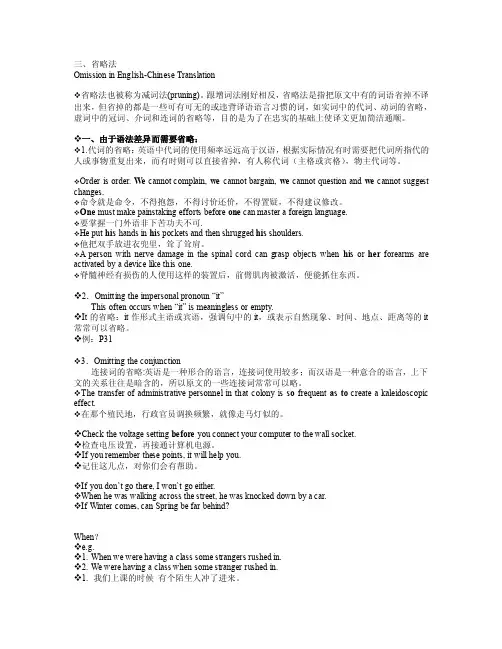
三、省略法Omission in English-Chinese Translation省略法也被称为减词法(pruning)。
跟增词法刚好相反,省略法是指把原文中有的词语省掉不译出来,但省掉的都是一些可有可无的或违背译语语言习惯的词,如实词中的代词、动词的省略,虚词中的冠词、介词和连词的省略等,目的是为了在忠实的基础上使译文更加简洁通顺。
一、由于语法差异而需要省略:1.代词的省略:英语中代词的使用频率远远高于汉语,根据实际情况有时需要把代词所指代的人或事物重复出来,而有时则可以直接省掉,有人称代词(主格或宾格),物主代词等。
Order is order. W e cannot complain, we cannot bargain, we cannot question and we cannot suggest changes.命令就是命令,不得抱怨,不得讨价还价,不得置疑,不得建议修改。
One must make painstaking efforts before one can master a foreign language.要掌握一门外语非下苦功夫不可.He put his hands in his pockets and then shrugged his shoulders.他把双手放进衣兜里,耸了耸肩。
A person with nerve damage in the spinal cord can grasp objects when his or her forearms are activated by a device like this one.脊髓神经有损伤的人使用这样的装置后,前臂肌肉被激活,便能抓住东西。
2.Omitting the imp ersonal pronoun “it”This often occurs when “it” is meaningless or empty.It的省略:it作形式主语或宾语,强调句中的it,或表示自然现象、时间、地点、距离等的it 常常可以省略。
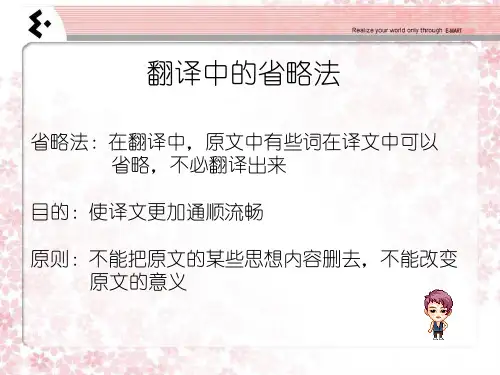
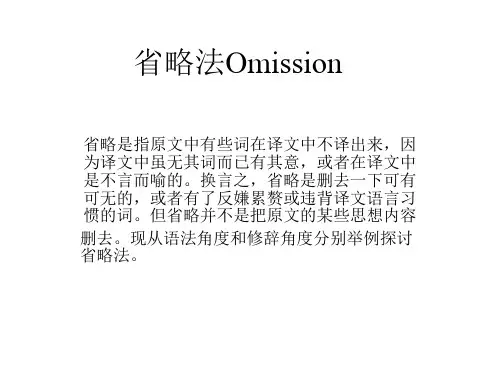
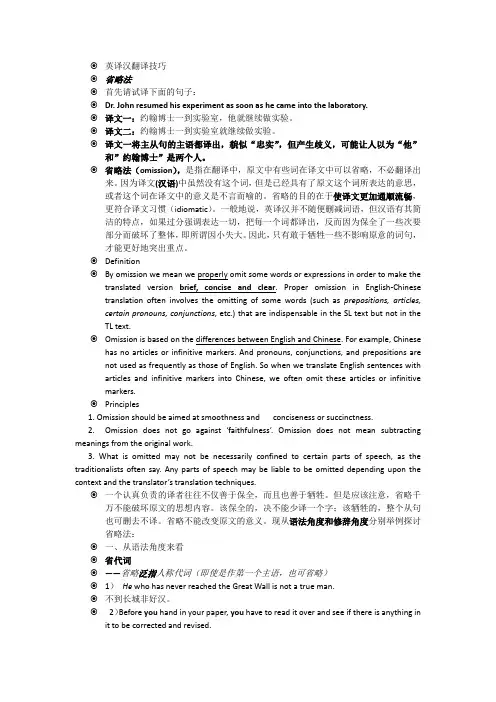
∙英译汉翻译技巧∙省略法∙首先请试译下面的句子:∙Dr. John resumed his experiment as soon as he came into the laboratory.∙译文一:约翰博士一到实验室,他就继续做实验。
∙译文二:约翰博士一到实验室就继续做实验。
∙译文一将主从句的主语都译出,貌似“忠实”,但产生歧义,可能让人以为“他”和”约翰博士”是两个人。
∙省略法(omission),是指在翻译中,原文中有些词在译文中可以省略,不必翻译出来。
因为译文(汉语)中虽然没有这个词,但是已经具有了原文这个词所表达的意思,或者这个词在译文中的意义是不言而喻的。
省略的目的在于使译文更加通顺流畅,更符合译文习惯(idiomatic)。
一般地说,英译汉并不随便删减词语,但汉语有其简洁的特点,如果过分强调表达一切,把每一个词都译出,反而因为保全了一些次要部分而破坏了整体,即所谓因小失大。
因此,只有敢于牺牲一些不影响原意的词句,才能更好地突出重点。
∙Definition∙By omission we mean we properly omit some words or expressions in order to make the translated version brief, concise and clear. Proper omission in English-Chinese translation often involves the omitting of some words (such as prepositions, articles, certain pronouns, conjunctions, etc.) that are indispensable in the SL text but not in the TL text.∙Omission is based on the differences between English and Chinese. For example, Chinese has no articles or infinitive markers. And pronouns, conjunctions, and prepositions are not used as frequently as those of English. So when we translate English sentences with articles and infinitive markers into Chinese, we often omit these articles or infinitive markers.∙Principles1. Omission should be aimed at smoothness and conciseness or succinctness.2. Omission does not go against ‘faithfulness’. Omission does not mean subtracting meanings from the original work.3. What is omitted may not be necessarily confined to certain parts of speech, as the traditionalists often say. Any parts of speech may be liable to be omitted depending upon the context and the translator’s translation techniques.∙一个认真负责的译者往往不仅善于保全,而且也善于牺牲。
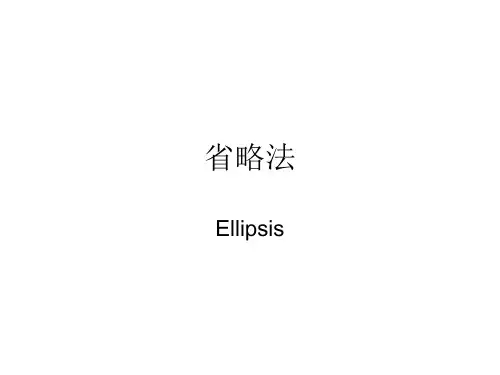
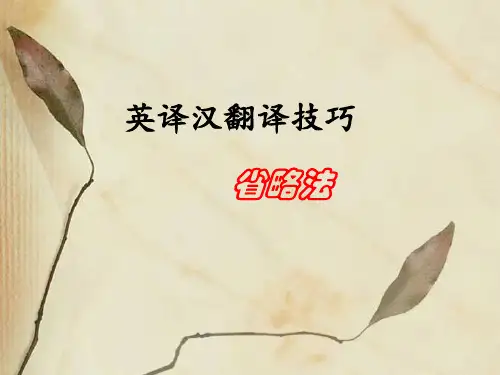
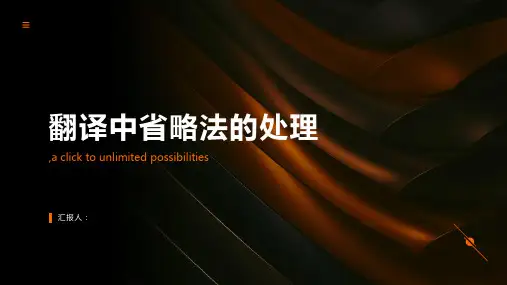

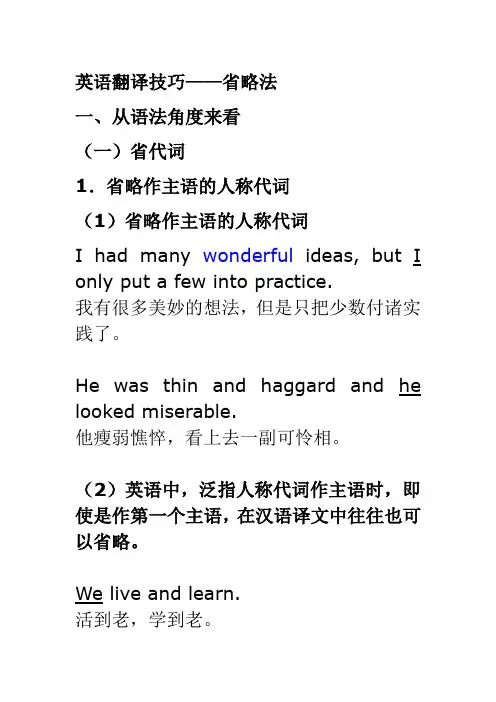
英语翻译技巧——省略法一、从语法角度来看(一)省代词1.省略作主语的人称代词(1)省略作主语的人称代词I had many wonderful ideas, but I only put a few into practice.我有很多美妙的想法,但是只把少数付诸实践了。
He was thin and haggard and he looked miserable.他瘦弱憔悴,看上去一副可怜相。
(2)英语中,泛指人称代词作主语时,即使是作第一个主语,在汉语译文中往往也可以省略。
We live and learn.活到老,学到老。
When will he arrive?-You can never tell.他什么时候到?--说不准。
The significance of a man is not in what he attained but rather in what he longs to attain.人生的意义不在于已经获取的,而在于渴望得到什么样的东西。
2.省略作宾语的代词The more he tried to hide his mistakes, the more he revealed them.他越是想要掩盖他的错误,就越是容易暴露。
Please take off the old picture and throw it away.请把那张旧画取下来扔掉。
3.省略物主代词I put my hand into my pocket.我把手放进口袋。
She listened to me with her rounded eyes.她睁大双眼,听我说话。
(二)代词it的省略Outside it was pitch dark and it was raining cats and dogs.外面一团漆黑,大雨倾盆。
He glanced at his watch; it was 7:15. 他一看表,是七点一刻了。
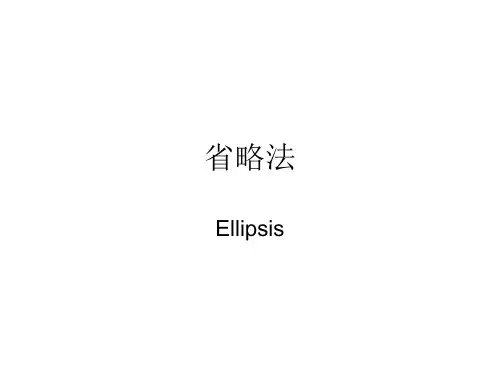
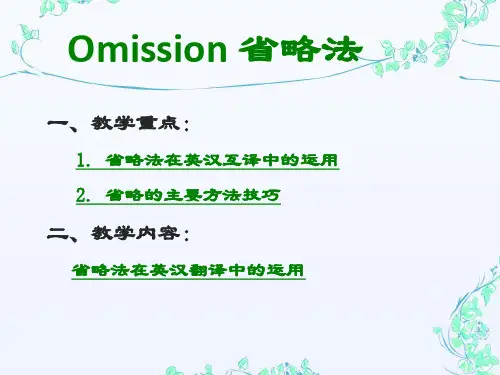
第一节省略法所谓省略”并不是把原文的意义删去,而是省略一些可有可无的,或者有了反而显得累赘甚至违背译文语言习惯的词。
一、结构考虑的省略1代词的省略A •省略作主语的代词在英文句子中,作主语的代词较多。
为了使译文前后句子的意思紧凑,避免重复用词,或者为了使译文前后句子的主语能清楚地表示出来,有时可以将作主语的代词省去。
但省去的人称代词在意思上仍明显地包含在译文里。
例如:1) . That is the way I am, and try as I_ might,丄haven ' t been able to change it.但我就是这个脾气,虽然几经努力,却未能改变过来。
Like his friends he had many wonderful ideas, but _he only put a few into practice.2)像他的朋友一样,他头脑里虽然有许多美妙的想法,却只有少数付诸实施。
B. 在英语句子中,泛指的人称代词常常不译出来。
例如:1) One is never too old to learn. 活到老,学到老。
2) They say it ' s so.据说是这样。
C. 作宾语的代词往往也可省略。
在英语句子中,有时作宾语的代词,无论在前面是否提到过,翻译成汉语的时候往往可以不译出来。
例如:1) The following letter will explain itself and needs no apology.下面的话一看就明白,用不着道歉。
2) If you have read these stories, tell them in your own words.如果你读过这些故事,就用自己的话讲出来。
3) The more he tried to hide his warts, the more he revealed them.他越是要掩盖他的烂疮疤,就越是会暴露。
第十节省略法省略是删去一些可有可无的,或违背译文语言习惯的词。
一.从语法角度来看(一)省代词1.省略作主语的人称代词(1)英语中通常每句都有主语,如主语不变,译成汉语时不必重复。
1)He was thin and haggard and he looked miserable. 2)But it’s the way I am, and try as I might, I haven’t been able to change it.3)They had murdered his father, they had taken the best of him, they had crushed his whole family.4)Laura wished now that she was not holding that piece of bread-and-butter, but there was nowhere to put it and she couldn’t possibly throw it away.1)他消瘦而憔悴,()看上去很惨。
2)但我就是这个脾气,()虽然几经努力,()却未能改变过来。
3)他们害死了他的父亲,()榨干了他的精力,()毁了他的全家。
4)这时劳拉宁愿()手里没有这块涂上黄油的面包,拿着又没有地方放,()又不可能扔掉。
作业:1.I am 78 years old; I have been confined to my room with a paralytic stroke for the past 14 months.2. Like his friend he had many wonderful ideas, but he only put a few into practice.3. We can measure the amount of water in a pot, but we can’t measure its heat. We haven’t an instrument for that.4. The Grand Dukes always liked new ideas, and later they were good friends of Galileo.(2)泛指的英语人称代词作主语时,即使是第一个主语,汉译时也可省略。